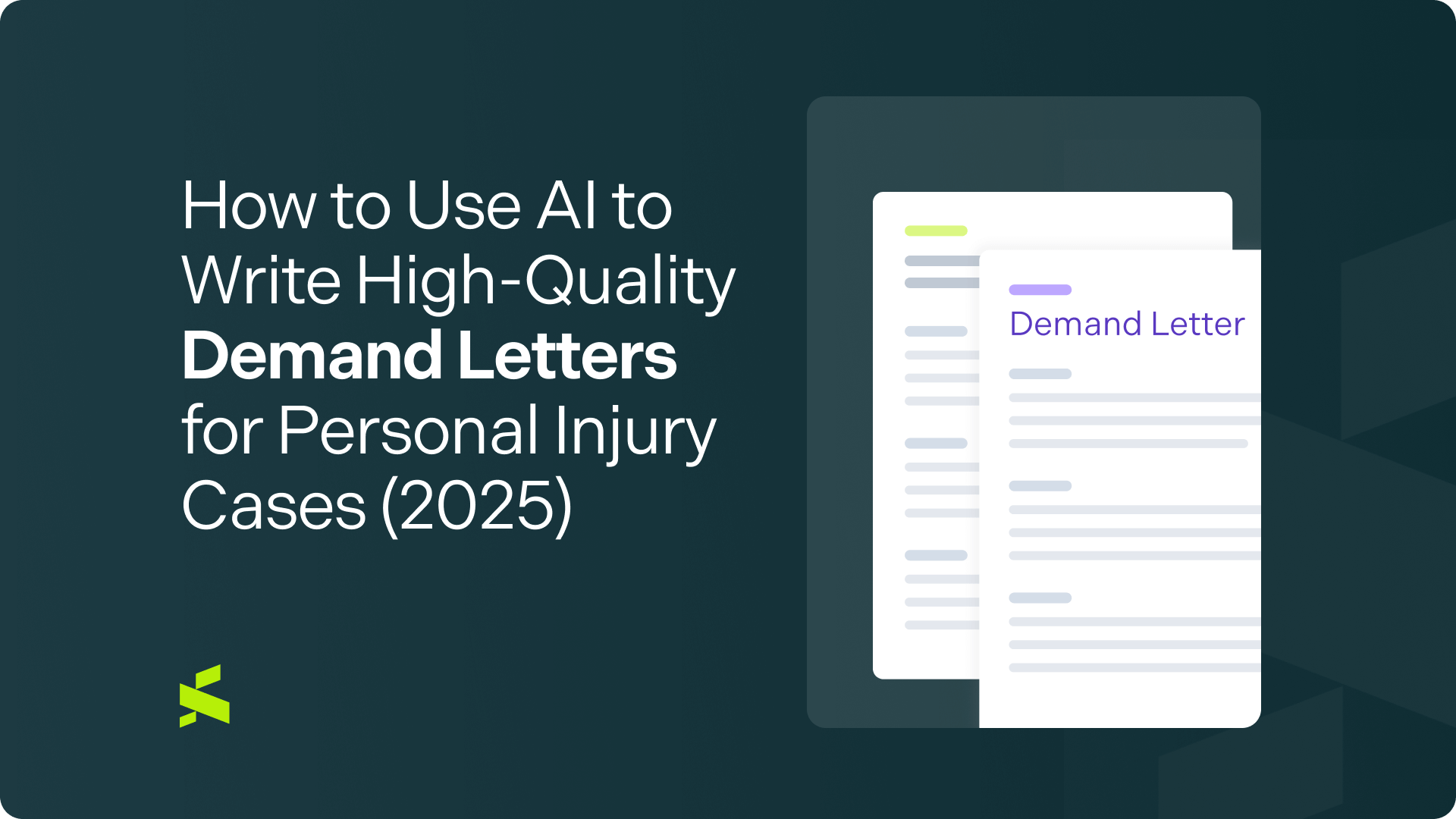AI is changing how personal injury firms draft demand letters. Instead of weeks of record review and manual drafting, legal AI tools can build medical chronologies, surface key facts, and generate persuasive narratives in hours. The result: faster output, stronger evidence-backed letters, and more leverage in settlement negotiations. Firms using AI report 3X more demands, 80+ hours saved per case, and higher policy-limit recoveries, all while staying HIPAA- and GDPR-compliant.
Done right, it forces insurers to pay attention, and sometimes even to pay limits. Done wrong, it drags the fight out for years.
The trouble is, writing them the old way is painfully slow. Weeks of reviewing records, building timelines, and stitching evidence together. And while generic AI tools promise shortcuts, they usually spit out drafts that feel robotic – the kind of thing adjusters spot and dismiss in seconds.
This is where legal-specific AI changes the game. It lets firms produce detailed, persuasive, evidence-backed demand letters at speed and without sacrificing control over tone, style, or accuracy. The result: letters that move faster, settle higher, and put leverage back in the hands of plaintiffs.
This guide breaks down how to do it. You’ll see:
- How AI fits into each stage of the demand letter workflow
- Real-world examples of firms using AI to improve settlement outcomes
- Sample prompts for tightening arguments and embedding evidence securely
Step 1: Intake, file collection, and policy limits
Every demand letter begins long before medical records hit the AI system. The first step is intake and file collection – from the client, providers, and other sources.
Medical records retrieval
Every personal injury case starts with records. Until those files are in hand, nothing else can move – no evaluation, no chronology, no demand. That’s why medical record retrieval is often the single biggest bottleneck for firms.
Specialized vendors step in to solve this. Companies like Yocierge and National Record Retrieval handle the heavy lift of reaching out to providers and collecting the full set of records, bills, exhibits, photos, MRIs, police reports, and PT notes that anchor a case.
Once collected, these files are either pushed manually or synced through a firm’s CMS before flowing into an AI system. From there, attorneys can immediately begin structuring chronologies and drafting persuasive demand letters.
Without fast, reliable record retrieval at the front end, every downstream step slows down. With vendors like Yocierge and NRR, firms can clear that first hurdle quickly and keep cases moving.
But the real make-or-break detail is identifying the insurance policy limit.
Why? Because it sets the ceiling on recovery and helps firms decide how much effort to put into each case. A $25,000 policy looks very different from a $1M umbrella policy.
Traditionally, policy limits can be discovered through a mix of formal and informal tactics:
- Formal Requests: Letters of representation, statutory disclosure rules (in states like California, Florida, and New York), or early discovery demands.
- Informal Channels: PI firms sometimes hire private investigators and can get limits through networks and backchannels. It’s common practice in certain states and rules vary by state.
AI makes this stage faster by helping attorneys:
- Parse intake notes to surface missing documents or inconsistencies.
- Cross-check public records (DMV, business filings) for minimum coverage.
- Organize incoming files into a structured repository that ties directly into later steps like chronology-building.
Bottom line is, without clear policy limit intel at intake, even the most persuasive demand letter may be fighting uphill.
Step 2: Evidence in → AI-assisted medical chronologies out
Every strong demand letter starts with a rock-solid foundation: a clean, structured timeline of medical events. Without it, the narrative risks being incomplete or inconsistent and adjusters will seize on those gaps. Traditionally, paralegals might spend days combing through thousands of pages of medical records to build this chronology by hand.
AI changes that first step entirely. It can process massive document sets in minutes, extracting dates, providers, diagnoses, and treatments, then pinning every fact back to its original source file. The output is an interactive medical chronology that attorneys can query, filter, and refine in real time.
That means you start with a reliable case snapshot from day one: a timeline that shows the full arc of the client’s medical journey, flags breaks in treatment, highlights symptom progression, and organizes every bill, record, and note into the story you’ll eventually tell in the demand.
Think of it as building your demand letter on steel beams instead of paper scaffolding. Faster, more thorough, and still verified by human review to ensure it holds up in court.
{{cta-1="/blog-components/ai-demand-letters-how-to-write-stronger-personal-injury-demands-with-ai"}}
Step 3: Turn facts into a persuasive demand letter (faster)
Once the chronology is built, the next challenge is turning raw facts into a narrative that wins. At scale – when a firm is generating dozens of demands per month – the bottleneck is the stop-and-start process of bouncing between mining the data and shaping the story.
AI collapses that divide. Instead of spending one block of time combing through records for key details, and another block drafting from scratch, you can fluidly do both at once.
As you explore the medical chronology, the AI can highlight “threads” (symptom progressions, missed workdays, emotional impact) and let you stockpile them for later. When you’re ready to draft, those insights are already waiting.
That dual mode is where time savings multiply. You can:
- Draft multiple narrative versions instantly (clinical, emotional, or concise) then decide which angle hits hardest.
- Surface vivid human details like client journals, deposition excerpts, or intake notes become quick narrative building blocks.
- Edit with total control and refine tone, style, and emphasis on the fly, without losing the connection to source evidence.
The result is a demand letter narrative that’s not only written faster, but grounded in the evidence that matters most. You stay in control of persuasion, the AI just eliminates the friction between analysis and drafting.
The point isn’t to let AI “write” your story. It’s to collapse the time it takes to get to a strong first draft, so your energy goes into sharpening the argument and highlighting the facts that maximize value.
{{cta-2="/blog-components/ai-demand-letters-how-to-write-stronger-personal-injury-demands-with-ai"}}
Step 4: Stress-testing your AI-assisted demand letter
This is the stage where an attorney’s judgment matters most: setting the right number, anticipating counterarguments, and walking into negotiation with leverage. AI won’t replace that skill, but it makes the prep sharper and faster.
1. Stress-testing your draft.
You can prompt AI to act like a skeptical adjuster: “Find weaknesses in this letter from the insurer’s perspective.” It might flag a gap in treatment, unclear causation, or weak language around damages. You get to fix those issues before the other side exploits them.
2. Preparing rebuttals in advance.
Insurance pushback is predictable: “Your client’s injuries were pre-existing,” or “The medical bills are excessive.” With AI, you can draft tailored counterarguments ahead of time. That way, when the objection comes, you’ve already got the language and evidence lined up.
AI ensures you walk into negotiation with fewer blind spots and more leverage.
Sample AI prompts for stronger demand letters
The value of AI is in its ability to refine drafts in seconds, test different tones, and make sure every fact is backed by evidence. Here are a few example prompts you can use to sharpen a demand letter:
- Bring in vivid details
“Highlight my client’s pain and suffering in this section, using specific daily-life examples.” - Reference key documents
“Cross-check this section with the life impact report and incorporate all ways the collision affected my client’s ability to work.” - Incorporate new records
“Include details from the October 13 MRI report and explain how it supports ongoing treatment needs.” - Adjust tone for negotiation
“Rewrite this section to sound firm but professional, emphasizing liability without sounding aggressive.” - Test multiple drafts
“Generate three variations of the damages section: one concise, one emotional, one highly technical.”
{{cta-3="/blog-components/ai-demand-letters-how-to-write-stronger-personal-injury-demands-with-ai"}}
IMPORTANT: Demand letters contain sensitive client and medical information. If you’re using AI, make sure you’re on a HIPAA-compliant, GDPR- and SOC 2–certified platform. That way you get the efficiency benefits without risking security or confidentiality.
Proven Results: How PI firms are already using AI in demands
PI firms are already putting it to work and seeing measurable returns. The benefits show up across speed, scale, and settlement value:
- Increased capacity
When drafting time drops from weeks to hours, firms can simply do more. At Lundy Law, attorneys 3X’d their monthly output of demand packs (jumping from 30 to around 110 and prepared 20–30 more cases each month). That extra capacity translated directly into higher revenue and faster settlements.
Read the Lundy Law case study →
- Massive time savings for staff
Paralegals at J. Chrisp Law reported reclaiming 80 hours per case by automating medical record entry and chronology building. What once felt like two full-time jobs of data entry became time freed for higher-value work.
Read the J. Chrisp Law case study →
- Higher policy limit recoveries
At GDH Law in Maryland, one AI-generated demand included medical chronologies, police reports, photos, and economic analysis. The insurer quickly tendered policy limits, and in a rare outcome, the defense attorney personally contributed additional money on top. As Gwen Marie Davis put it: “My secret sauce is having that demand that really was excellent.”
Read the GDH Law case study →
FAQs about using AI in demand letter drafting
Q: Can AI be used to draft demand letters?
Yes, AI can generate structured first drafts, build medical chronologies, and integrate exhibits in minutes. The key is that attorneys still refine strategy, tone, and accuracy, making AI a drafting assistant rather than a replacement.
Q: Are there HIPAA-compliant AI tools for demand letters?
Yes. Some legal AI platforms are HIPAA-, GDPR-, and SOC 2–compliant, meaning sensitive client and medical data stays private and secure. Using a compliant platform is essential. Foundation models like ChatGPT don’t meet these standards.
Q: What are some ethical considerations when using AI for demand letters?
Attorneys must supervise AI output, verify facts against source records, and maintain confidentiality. The ABA has said this is permissible if lawyers remain the final decision-makers, just as they would when delegating work to a junior associate or paralegal.
Q: Why not just use ChatGPT or another LLM to co-write my demand letter?
Generic LLMs can’t securely handle case files, don’t tie facts to exhibits, and often produce boilerplate language that insurers can spot instantly. Legal AI tools are built for this workflow.
Q: How should I measure success of using AI to write demand letters?
Look at both efficiency and outcomes: time saved per demand, number of additional demands your firm can produce each month, and whether settlement values or policy-limit tenders increase. Firms report saving 80+ hours per case and tripling demand output without sacrificing quality.
Q: Will using AI affect the credibility of my demand letter with insurers?
Not if it’s done right. Insurers are quick to dismiss boilerplate or generic language, but legal AI is built to cross-link every claim to source evidence, making the letter harder to challenge. The attorney still controls tone, strategy, and personalization, so what the insurer sees is a well-documented, persuasive package – not something that looks “AI-generated.”





